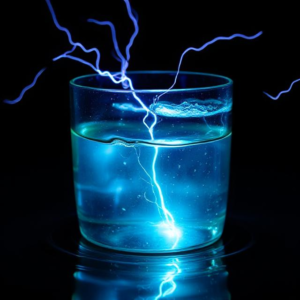Conduction of Electricity in Liquids:
To understand how electricity flows in liquids, we need to know about conductivity and how it works in different types of liquids.

What is Electrical Conduction in Liquids?
- Electrical conduction in liquids happens when the liquid can carry an electrical current. For a liquid to conduct electricity, it must contain charged particles called ions (positively or negatively charged atoms or molecules).
- When electricity (which is a flow of electrons) is applied to the liquid, the ions move, carrying the electric current. This movement of ions is what makes the liquid conduct electricity.
How Does it Work?
- When you connect a power source (like a battery) to a liquid, the positive ions move towards the negative side (the cathode), and the negative ions move towards the positive side (the anode).
- The movement of these ions allows electrical current to flow through the liquid.
Conductivity:
- Conductivity is a measure of a material’s ability to conduct an electric current. In liquids, it depends on the number of ions present in the liquid and how easily they can move.
- Higher conductivity means that the liquid can conduct electricity well (lots of free ions), and lower conductivity means it’s harder for the liquid to carry electricity (fewer or weaker ions).
Conductivity of Water:
Water, like other liquids, can conduct electricity, but its ability to do so depends on how many dissolved ions it contains.
- Pure Water:
- Pure water (distilled water, for example) is a very poor conductor of electricity. This is because pure water contains very few ions (mostly hydrogen ions and hydroxide ions, which are present in tiny amounts).
- Conductivity of pure water is very low because there aren’t enough ions to carry the electric current efficiently.
- Impure Water:
- When impurities (like salts, minerals, or other substances) dissolve in water, they split into ions. For example, when salt (NaCl) dissolves in water, it breaks down into sodium (Na⁺) and chloride (Cl⁻) ions.
- These ions increase the conductivity of water. The more dissolved substances (or ions) there are in water, the higher the conductivity.
- Salt Water:
- Salt water has high conductivity because salt dissolves into ions in the water, allowing it to carry more current. So, seawater or tap water that contains minerals and salts is a much better conductor than pure water.
Factors Affecting Conductivity of Water:
- Ion concentration: More ions = higher conductivity. For example, salty water conducts electricity much better than pure water because it has more ions.
- Temperature: Warmer water tends to have higher conductivity because heat increases the movement of ions in the water.
- Type of ions: Some ions are better at conducting electricity than others. For example, sodium (Na⁺) and chloride (Cl⁻) ions conduct electricity better than other types of ions.
Summary:
- Electricity in liquids is conducted by the movement of ions (charged particles). Liquids that have more ions can conduct electricity better.
- Conductivity measures how well a liquid can conduct electricity, and it depends on the number of ions in the liquid.
- Pure water has low conductivity because it has very few ions, while impure water or saltwater has high conductivity because it contains more ions.
Tags: anode, battery, cathode, charged particles, chloride ions, Cl⁻, conductivity, conductivity of water, dissolved salts, distilled water, electric current, electric flow in liquids., electrical charge carriers, electrical conduction, Electricity, electrochemical process, electrolysis, few ions, flow of electricity, high conductivity, impure water, ion concentration, ion mobility, ions, liquids, mineral content, movement of ions, Na⁺, negative ions, poor conductor, positive ions, power source, pure water, salt water, seawater, sodium ions, tap water, temperature effect, type of ions, warm water


